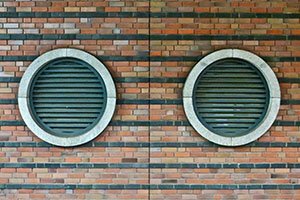The Benefits of Proper Attic Ventilation
Table of Contents
Is Attic Ventilation Necessary
Common Attic Ventilation Problems
How Can I Improve My Attic Ventilation
How Much Ventilation Should An Attic Have
What Are The Different Types Of Roof Vents
What Is The Best Way To Vent An Attic Roof? Is A Ridge Vent Or Roof Vent Better?
There are lots of things to consider when converting your attic, such as reinforcing its structure, installing flooring, and, of course, the type of room you want your conversion to be. However, another, often overlooked, factor when renovating your attic space is its ventilation.
Proper ventilation is crucial for cooling down space in your attic so it’s habitable, preventing roof damage and other avoidable repairs, and preserving the structural integrity and value of your home.
So with that firmly in mind, let’s take a look at the benefits of proper attic ventilation and how you can properly ventilate your home.
How Attic Ventilation Works
Attic ventilation works through a combination of two principles: the stack effect and the wind effect. Combined, they are responsible for what’s called passive ventilation, which requires two types of vents:
- Exhaust vents: These are installed at the peak of the roof and allow hot air to leave the attic.
- Intake vents: These are installed under the eaves of the roof and allow cool air to enter the attic.
Now as heated air rises, it creates a greater pressure at the highest points of your attic, eventually causing it to leave through the exhaust vents. As the warm air leaves the attic, it depressurizes and brings in more air to address the imbalance; this will be cool air brought in through the intake vents. This process is called the stack effect.
Meanwhile, as the wind blows against the outside of your house, it causes an increased amount of cool air to enter your house its intake vent. This, in turn, causes more hot air to leave your attic via its exhaust vents – which then causes more cool air intake and so on. This is known as the wind effect.
Is Attic Ventilation Necessary?
Attic ventilation is necessary as it prevents or solves a variety of problems.
Prevents Roof Damage
Attic ventilation prevents a heat buildup which can affect the roof above. In particular, it protects your roof shingles from cracking from overheating.
Prevention of Excess Moisture
Ventilation also prevents excess moisture buildup, which can lead to several problems.
Roof Damage
As well as overheating, excess moisture in your attic can cause damage to your roof. This could be in the form of rust forming on the metallic materials on your roof, like nails and venting ducts. Similarly, mould and fungus may start to form.
Damp and Mould
Too much moisture leads to increased dampness in your attic and the development of mould on the wood that comprises its structure.
Paint Damage
Excess moisture can cause your paint to peel or blister – inside and outside. So you can add decorating costs to the repair bill created by poor ventilation!
Reduces Energy Costs
If warm air isn’t allowed to escape, it builds up and your AC units have to work overtime to cool the house, resulting in higher electricity bills.
Prevents Temperature Extremes
When hot air builds up in your attic, it soon flows into your living space, making your house uncomfortably warm. This is especially true if you’ve converted, or are planning on converting, your attic, as adequate airflow is a priority if its going to be an inhabited room (conversion ideas for living space).
Common Attic Ventilation Problems
Soffits Blocked by Insulation Batts
This occurs where the insulation batts you’ve installed have been positioned in such a way that they block your soffit vents. This prevents fresh air from freely flowing into your attic.
Hip Roofs
Hip roofs are more difficult to ventilate because of their shape., which, often, is essentially a pyramid with a flat top. The ‘hips’ on such a roof are long ridges that connect its lower corners to its horizontal ridge at the top. These can be a challenge to ventilate because they reduce the venting space in the upper roof.
Worse still, the hip roof’s tall framing prevents the proper upward movement of air, negating the stack effect. This creates pockets of warm, stagnant air which can’t escape the attic.
Roof Valleys
A roof valley occurs where two roof lines meet and create a similar problem to hip roofs. Roof valleys create dead spots of stagnant air which are difficult to vent.
How Can I Improve My Attic Ventilation
There are a few effective ways to improve ventilation in your attic.
Make Sure Your Existing Ventilation Isn’t Blocked
Check your existing soffit vents for blockages and clear them where possible. They may have become clogged by dirt and debris or could have been accidentally obstructed if you installed or readjusted your attic insulation. Your soffit vents can be cleared with compressed air or water or by repositioning the insulation batts in the way of the vents.
Increase The Size of Your Existing Ventilation
The holes in your existing soffit vents may be too narrow, leading to inadequate ventilation. If this is the case, you can get a roofing company to inspect the vents and increase the size of their holes
Add Ventilation
The most foolproof way to improve the ventilation in your attic is to add more ventilation. Your easiest options are soffit vents for air intake and adding a ridge vent to ensure proper outflow. However, the best course of action for ventilating your attic depends on the shape and structure of your roof so it’s best to consult a roofing specialist.
How Much Ventilation Should An Attic Have?
Although there are different suggestions on how to calculate the amount of ventilation your attic needs, the general rule of thumb is installing at least one event for every 25 – 30m2 (300ft2) of the attic floor.
This can vary considerably, however, depending on the size of your home and the way your roof is structured. For this reason, it’s best to seek the advice of a roofing specialist who’ll make sure your attic is properly ventilated, preventing otherwise avoidable problems down the line.
What Are The Different Types Of Roof Vents?
There are two general categories of roof vent: exhaust vents and intake vents. Exhaust vents expel hot air while intake vents drew in cooler air to replace it. The two work in tandem to bring down the temperature of your house and prevent all of the problems associated with an overheated attic. Here’s a brief overview of the most common types of the roof vent.
Ridge Vents
Ridge vents are a type of exhaust vent that runs the whole length of your roof. As they span the entire length of the ridge and are at the very top of a roof, they’re an especially effective form of ventilation and are the most common type of exhaust vent. Also, they’re usually barely visible from ground level and can also be covered by special roof shingles.
Soffit Vents
Soffit vents are a type of intake vent that’s installed in the underside of the eaves of a roof. There are two categories of soffit vents: individual or continuous. Individual soffit vents are installed separately along the eaves of a roof, at calculated intervals. Continuous soffit vents run the length of the eaves in strips and provide more ventilation than individual soffits.
Cupola Vents
A cupola vent is a type of vent commonly found on barns and other larger buildings. A cupola is a hollow structure that sticks out from a building’s roof, resembling a chimney or a turret. They come in a variety of shapes and sizes but are usually square or hexagonal, with a domed or pointed top.
The vents on the side of a cupola let in fresh air (and release gases, in the case of barns and similar buildings). Larger, more extravagant cupolasones have windows and can be used as a lookout point.
Mechanical or Powered Vents
Sometimes, with low-angled roofs or heavily-gabled roofs, for instance, passive ventilation (relying on the stack effect and wind effect) is insufficient and doesn’t produce enough airflow. In such cases, an attic needs mechanical or powered vents.
Mechanical ventilation is usually achieved through the installation of wind-powered turbine vents, which work well in areas with consistent wind.
Similarly, powered exhaust vents use an electric or solar-powered fan to do the same job as a turbine. A standard powered exhaust vent turns on when the temperature inside the attic reaches a certain limit and runs until space cools down.
Gable Vents
A gable vent is found on the side of houses that have gable roofs may also have vents. They’re particularly useful as they’re able to act as intake and exhaust vents, depending on the direction of the wind. Better still, unlike many visible vents, gable vents can add to the aesthetic of your home instead of being an eye-sore.
What Is The Best Way To Vent An Attic Roof? Is A Ridge Vent Or Roof Vent Better?
In most cases, a ridge vent is a better choice for ventilating your attic.
First and foremost, ridge vents are superior because they are installed at the roof’s peak, the highest point possible, which allows warm air to escape from the attic. As a result, you only need one ridge vent, as compared to several box vents. What’s more, the design of a ridge vent means as the wind blows over the roof’s ridge, the wind effect pulls air out of the attic. At the same time, fresh air is sucked into the underside of the ridge vent, increasing the air circulation. Then, of course, there’s the aesthetic consideration and ridge vents blend in with the roofline, as opposed to roof vents that stick out of the house.
However, this isn’t to say roof vents don’t have their benefits. The main advantage of box vents is that they can serve as an alternative as an exhaust vent when a ridge vent isn’t feasible. A good example is using electric vents to extract heated air from awkwardly-shaped roofs, where it would have otherwise been trapped at the very top of the attic.
——
Although attic ventilation may not be at the top of your list when it comes to repairing or renovating your home, neglecting it can have some significant ramifications. In the short term, the temperature fluctuations caused by poor attic ventilation decrease your sense of comfort while increasing your energy bills at the same time. Long term, meanwhile, all that excess heat and moisture causes damage to the structure of your attic and shortens the lifespan of your roof.
Making sure your attic is adequately ventilated now is guaranteed to save you a lot of time and money down the line.
Do you feel your attic could do with more ventilation? Would you like to check if your current ventilation setup is driving up your energy costs? Contact us for a hassle-free, no-obligation quote.







